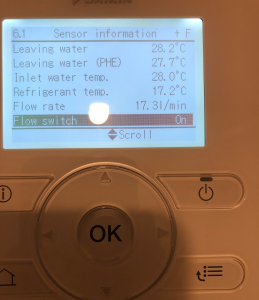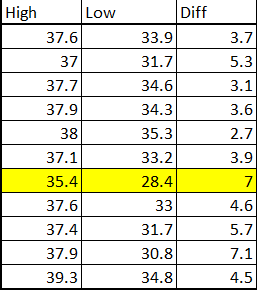Thanks for the pointers.
Regarding the bypass valve, I assume winding it in will effectively shut it off for now would it?
The diverter valve is operating correctly now, the first installer got it wrong but was corrected soon after.
The BUH has only operated once, in the cold snap at the end of November but that was when the thermostat kept interrupting the running of the pump so it wasn't operating effectively. It didn't operate for the whole of December according to the stats in the controller but I can isolate it via a FCU so I'll take that advice.
COP for the last few days is 3.4 which I think is pretty reasonable but it has been very mild.
@hydros it should do but it will depend on system hydraulic resistance. Can’t hurt to try it
id definitely be looking to alter the comp curve too. Run it lower for longer will always be cheaper. Mines targeting about 30 degrees at the moment running from 5:00 to 22:00. I just watch my overall energy usage for feedback but will be changing to a lower output gen6 Samsung when I get round to fitting it. Then I’ll get some data out of it as the old gen3 does nothing.
Internationally recognised award winning installer of heat pumps and stuff
Hi Mars,
Thank you for the kind wishes, and my wife and I would like to wish you, your wife and all the forum participants a happy and prosperous new year.
I would also like to thank you and your wife for setting up the forum, which I feel certain is proving very useful and helpful to many.
Posted by: @jonathansThanks very much -- I think I understand this now, as well as the source of my confusion. My Vaillant 12kW operates only w/the Vaillant Sensocomfort controller, ie, it has no other independent thermostat. So if I grasp your explanation, this means that even under weather compensation, I would use that controller as usual. That is, I would set a set-back temperature and then any other higher-heat demand periods (this is what I mean by 'as usual' -- putting in exactly the desired temperature rather than something slightly higher), initiate the function that adjusts the flow temp based on the current room temp, and then just let the ASHP run itself & adjust flow temps as it sees fit.
Have I correctly grasped the difference between the ASHP controller and the thermostat in your explanation?
Hi Jonathans,
Because your system is using the Vaillant SensoComfort controller you don't have to be concerned about thermostats. If my understanding is correct, you set the desired room temperature on your controller and you can also program setback temperatures as required.
I've altered the curve. Currently running at 28-29C today and the house is plenty warm enough. Would bigger radiators result in an improved COP? I'm guessing I could put more heat into the house at a lower running temperature. Very few of my radiators were changed during the retrofit, most were already K2, but upgrading a few to a bigger output is within my skill set.
I think I could get away with a smaller heat pump and improve efficiency but it'll be a few years before I can justify that, and I really need a good cold snap longer than a couple of days to prove it.
@hydros general rule is the bigger the emitter the lower the temp can be. Also, lowering the temp will allow you to run the unit longer which is generally very cheap to do. There will be a point of diminishing returns though so a decent heat loss calc to allow sizing of rads at various temps would be useful.
Internationally recognised award winning installer of heat pumps and stuff
Posted by: @hydrosI've altered the curve. Currently running at 28-29C today and the house is plenty warm enough. Would bigger radiators result in an improved COP? I'm guessing I could put more heat into the house at a lower running temperature. Very few of my radiators were changed during the retrofit, most were already K2, but upgrading a few to a bigger output is within my skill set.
I think I could get away with a smaller heat pump and improve efficiency but it'll be a few years before I can justify that, and I really need a good cold snap longer than a couple of days to prove it.
Hi Hydros,
You could use the modelling tool that I produced to see the effect of changing the size of heat emitters.
Hi Derek
I would be good to try some different numbers in a modelling tool. Are you able to send me a copy please?
COP still hovering around the 3.4 mark which is nice and consistent, running with a leaving water temperature of 30C but still 6 cycles per hour. Would bigger radiators do anything about the cycling, or is that just a factor of the house not needing the heat and the pump not being able to modulate low enough?
@hydros yes, it’s because you aren’t losing enough heat from the water return. You should be able to see the temps on the controller. Most are set to run around a 5 degree differential.
if you can get flow and return temps as well as external air temp, you will be able to see what’s going on a bit better
I set my heat pump up to have a minimum flow temp of 20 but a comp curve set to minimum 30. I can play with the flow temp by +/-5 degrees to see what works best.
are you finding the house is warm enough at that flow temp?
Internationally recognised award winning installer of heat pumps and stuff
My controller is set to a 7C differential but I'm definitely not seeing that differential at the lower leaving temperature, though the house is plenty warm enough, it's 21.5C in the living room.
Current view is leaving water (flow) 28.2C, inlet (return) temp 28.0C, external air temp 9.0C, flow rate 17.l/min, I've seen the difference up to 3C between flow and return but only when the pump is running at ~21l/min.
When the outside temperature is cooler and the pump is running warmer the difference does sit around the 7C difference mark. When I recorded figures back before Christmas I got figures around 44C leaving and 37C on the return. Outside temp was about 2-3C if I remember correctly.
Posted by: @hydrosHi Derek
I would be good to try some different numbers in a modelling tool. Are you able to send me a copy please?
COP still hovering around the 3.4 mark which is nice and consistent, running with a leaving water temperature of 30C but still 6 cycles per hour. Would bigger radiators do anything about the cycling, or is that just a factor of the house not needing the heat and the pump not being able to modulate low enough?
Hi Hydros,
I have attached a copy of the modelling tool. I would suggest that you read the notes on the first sheet which explain how to use the tool.
Installing larger heat emitters could allow you to operate your system at a lower water flow temperature, but I doubt it would have much effect on the cycling. In fact it could cause cycling to occur down to lower outside air temperatures.
A further possible problem of changing selected radiators would be to unbalance the overall system, which when re-balanced may not show much improvement in overall performance. When was your system last balanced?
Hi Derek
I balanced the system about a month ago but it's not been done by a professional. I've watched some YouTube videos and have a IR thermometer to measure the in/out temperatures on the radiators. It's not perfect.
The highlighted line is the furthest rad from the heat pump. Maybe I should spend some more time trying to improve the balancing?
-
Weather compensation- why you should use it
18 hours ago
-
Rodents! A word of warning for heat pump owners
21 hours ago
-
Where has Watson gone?
22 hours ago
-
First time wall mounting an ASHP
2 months ago
-
How can I programme a setback for my Samsung Gen6 8kW heat pump?
2 months ago
- 26 Forums
- 2,396 Topics
- 54.3 K Posts
- 333 Online
- 6,077 Members
Join Us!
Worth Watching
Latest Posts
-
RE: Radiator sizing sanity check
@jamespa Luckily I have the whole process documented...
By Papahuhu , 8 minutes ago
-
RE: Recommended home battery inverters + regulatory matters - help requested
@batpred, @transparent thanks Since the i...
By JamesPa , 31 minutes ago
-
RE: Advice for a novice on Mitsubishi Ecodan 6kW
I hadn't spotted that there were two pumps in the UFH (...
By JamesPa , 2 hours ago
-
RE: Setback savings - fact or fiction?
Never assume it makes an ass of u and me! You need the...
By JamesPa , 2 hours ago
-
RE: New Mitsubishi Ecodan 11.2kW installation - L9 errors and maybe more
Before I answer your specific questions just one more t...
By JamesPa , 2 hours ago
-
RE: Help me keep the faith with my air source heat pump installation
@agentgeorge Fortunately the one thing that you *won't*...
By dr_dongle , 2 hours ago
-
RE: ASHP Energy Consumption: Aira 12kW heat pump
@chandykris Thank you for your detailed response.It is ...
By Wally , 3 hours ago
-
RE: Electricity price predictions
Great point, one of the key ones in my chat with Octopu...
By Batpred , 13 hours ago
-
RE: Running from backup generaor in powercut?
Definitely and professionals sometimes miss it. I had...
By Batpred , 13 hours ago
-

RE: New Fogstar 15.5kWh upright solution
Let me point out that there are many Chinese suppliers ...
By Transparent , 17 hours ago
-

RE: Weather compensation- why you should use it
@majordennisbloodnok — The Two Ronnies Mastermind sketc...
By cathodeRay , 18 hours ago
-
Just realised that this image of the cylinder cupboard ...
By Sheriff Fatman , 21 hours ago
-

RE: Rodents! A word of warning for heat pump owners
Two thoughts: 1: Let's ask @david-s if Primary Pro in...
By Transparent , 21 hours ago
-
RE: Solis S6-EH1P8K-L-PLUS – Why I Chose It and What I’ve Learned So Far
In the diagram below, I describe my understanding of th...
By Batpred , 22 hours ago
-
I need to have a look out for it. I know IBM feeds some...
By Batpred , 22 hours ago
-
-
RE: Daikin Atherma ASHP Cycling 6 Times an Hour?
Thanks for your reply. Yes that's a good idea to try a...
By John Marshall , 1 day ago
-

RE: Hot water heating in parallel with space heating
An external heat exchanger would need a pump which woul...
By bontwoody , 1 day ago
-
RE: Gen 6 Samsung ASHP losing 20C of DHW in 60 min directly after generation
@ecobaker Thanks for this. I've had it in both slots. ...
By andbeck , 2 days ago
-

RE: Air source heat pump circuit not operational
Welcome to the forums. If the thermostat shows it’s c...
By Mars , 2 days ago







